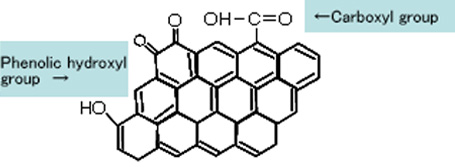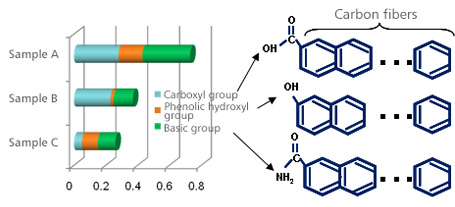Study and Analysis of a Root Cause of Failure
in Resin Composite Materials
Analysis of Functional Groups on the Surface of Carbon Materials
Don't you have any problem or difficulty with characterization of carbon materials?
Characterization and quantification of functional groups on the surface of the carbon materials can help better use of the carbon materials.
Outline of Functional Group Analysis
The carbon materials are widely used in the anode in lithium-ion secondary batteries, electrodes in the fuel cells, and electrode for capacitors, and further as a source of carbon fiber in carbon fiber reinforced plastic (CFRP).
The functional group on the surface of the carbon materials affects the electric properties (capacitance and resistance) as well as the battery life. The functional group on the surface of carbon fibers also plays an important role in adhesion of the carbon fibers to the matrix resin in CFRP.
Analysis Method
Boehm titration, an acid-base titration method is used to quantify the total acid groups, the strong acid groups, the phenolic hydroxyl groups, and the amide groups.
Analysis example of carbon surface functional group
Sodium hydroxide and sodium hydrogen carbonate are independently added to the specimens which are back-titrated with hydrochloric acid using the "automatic potentiometric titration method" under inert atmosphere.
(1) Total acid group (total acid): Hydrochloric acid consumption after addition of sodium hydroxide
(2) Strong acid group (carboxyl group): Hydrochloric acid consumption after addition of sodium hydrogen carbonate
(3) Weak acid group (phenolic hydroxyl group): Amount of total acid group - amount of carboxyl group
-
- → ↓
-
Information on the quantification of the functional groups on the surface of the carbon materials is useful not only for their characterization as the functional material but also for quality control in production of the carbon materials.
Analysis example (Table 1)
Modified products, carbon B and carbon C have higher total acid groups than conventional carbon A, suggesting higher electrochemical reactivity.
-

Typical functional group on thesurface of the carbon material
| Sample | Total acid (mmol/g) |
Phenolic hydroxyl group (mmol/g) |
Carboxyl group (mmol/g) |
|---|---|---|---|
| Conventional carbon A | 0.18 | 0.17 | 0.01 |
| Modified carbon B | 0.44 | 0.34 | 0.10 |
| Modified carbon C | 0.52 | 0.40 | 0.12 |
Analysis example of surface functional group of carbon fiber reinforced plastic (CFRP)
Characteristics of Carbon Fibers and a Role of the Functional Group on Their Surface
- Carbon fibers are strong, flexible and light in weight and used as the structural material in aircraft and aerospace fields.
To ensure the good characteristics as the structural materials it is important to integrally mold the carbon fiber with resins. In particular good adhesion between the carbon fibers and the resin in CFRP is critical and the fabrication technology is very important. - In the past the importance of controlling the functional groups on the surface of the carbon fibers was recognized, but its quantification is presumed to be difficult.
JFE-TEC extensively investigated the reproducible quantitative analysis method for each functional group on the surface of carbon fibers through dividing the functional groups into the carboxyl group, the phenolic hydroxyl group, and the basic group and established our own pretreatment method in sample preparation for this surface analysis.
Analysis Example for Identification of the Functional Group on the Surface of Carbon Fibers
-
- An analysis method for the functional group on the surface of carbon fibers
Pretreatment of carbon fibers with an acid or alkali
↓
Collection of products in the pretreatment
↓
Back-titration of the aliquot obtained
by potentiometric titration -



